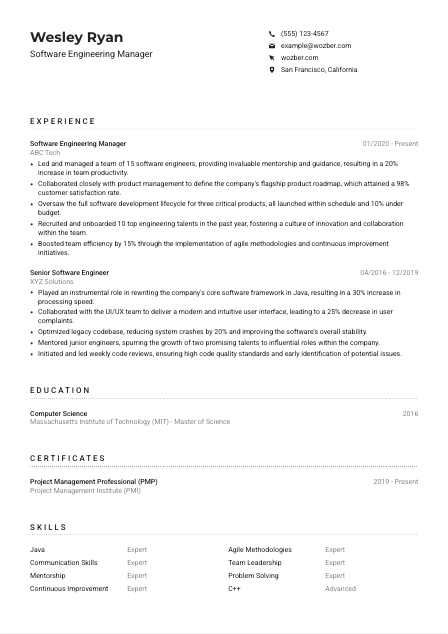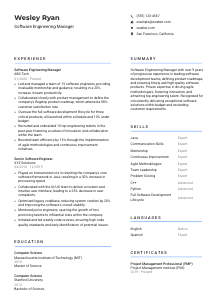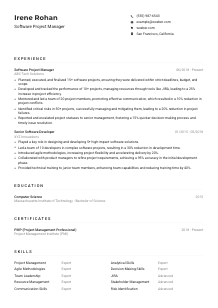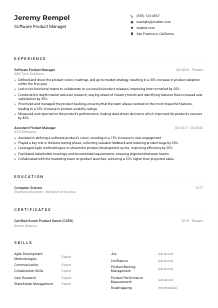Software Engineering Manager Resume Example
Leading code warriors, but your resume feels like a memory leak? Dive into this Software Engineering Manager resume example, engineered with Wozber free resume builder. It shows you how to architect your managerial flair alongside technical prowess, ensuring your career journey is as streamlined as optimized algorithms!

How to write a Software Engineering Manager Resume?
Embarking on the quest for the coveted Software Engineering Manager position? In the world of software development, where precision meets creativity, your resume is more than a document—it's the code that compiles your career. Imagine crafting it with the precision of a finely-tuned algorithm, tailored to resonate with the pulse of your dream role. Using Wozber, a free resume builder, we'll guide you through writing a resume that not only speaks the language of Applicant Tracking Systems (ATS) but also tells your compelling story through an ATS-friendly resume format.
Ready to compile your success? Let's dive into creating that winning resume.
Personal Details
In the digital realm of software engineering, your Personal Details section is like the header comments of your code: essential for understanding, yet succinct and to the point. Let's align this section to make a stellar first impression as a Software Engineering Manager.
1. Brand Yourself with Your Name
Think of your name as the class name in your resume 'code'—it defines who you are. Ensure it's prominently displayed, much like a class declaration, making it instantly recognizable. A slightly larger font might just be the syntax highlighting you need.
2. Job Title: Declare Your Target Position
Directly below your name, include the job title from the job description. This acts as a declaration, informing the 'compiler' (recruiter) the function you're optimized for. "Software Engineering Manager" is not just a title; it's your career objective made clear.
3. Contact Details: Your Parameters
Include your phone number and a professional email address—think of them as parameters through which opportunities can reach out to you. Correct syntax (no typos) is crucial here to ensure the calls to your 'function' don't return an error.
4. Location: Define Your Scope
"San Francisco, California" isn't just a string; it's a key parameter satisfying one of the job's requirements. It reassures your potential employers that no 'relocation exceptions' will be thrown in integrating you into their team.
5. Professional Profile: Optional Arguments
Consider linking your LinkedIn profile or personal website, akin to adding optional arguments to a function. They provide additional insights, supporting your main logic (resume) without overcrowding it. Ensure these platforms are current and mirror your resume.
Takeaway
Your Personal Details section sets the compile-time environment for your resume. Craft it to ensure smooth execution, making every line, every detail count. With the right 'syntax', you're one step closer to passing the compilation process (ATS) and making it into the hands of the hiring manager. Make it neat, precise, and reflective of your professional identity.





Experience
In the world of software engineering, your experience is your runtime library—rich, diverse, and crucial for performance. As a Software Engineering Manager, illustrating your technical leadership and project milestones is key. Let's adeptly architect your Experience section to showcase your programming prowess and managerial finesse.
- Led and managed a team of 15 software engineers, providing invaluable mentorship and guidance, resulting in a 20% increase in team productivity.
- Collaborated closely with product management to define the company's flagship product roadmap, which attained a 98% customer satisfaction rate.
- Oversaw the full software development lifecycle for three critical products, all launched within schedule and 10% under budget.
- Recruited and onboarded 10 top engineering talents in the past year, fostering a culture of innovation and collaboration within the team.
- Boosted team efficiency by 15% through the implementation of agile methodologies and continuous improvement initiatives.
- Played an instrumental role in rewriting the company's core software framework in Java, resulting in a 30% increase in processing speed.
- Collaborated with the UI/UX team to deliver a modern and intuitive user interface, leading to a 25% decrease in user complaints.
- Optimized legacy codebase, reducing system crashes by 20% and improving the software's overall stability.
- Mentored junior engineers, spurring the growth of two promising talents to influential roles within the company.
- Initiated and led weekly code reviews, ensuring high code quality standards and early identification of potential issues.
1. Decipher the Job Description
Begin like you would when tackling a new codebase – break down the job description. Isolate the 'functional requirements' directly pertaining to your experience. This meticulous approach ensures you address what the 'program' (employer) needs.
2. Chronology: Your Version Control History
Your career trajectory should be neatly chronicled with your most recent roles upfront, akin to a well-maintained Git repository. Each role—your job title, the company's name, and your tenure there—forms a commit in your professional version control system.
3. Achievement Statements: Your Commits
For each position, craft achievement statements that resonate with the job requirements. Like commits, they should be clear, concise, and significant. Statements like 'Led a team to improve system efficiency by 15%' showcase your impact and your role in achieving it.
4. Quantify Your Impact
Numbers speak volumes in the programming world. They do in your resume too. Quantifying achievements, like reducing system load times by 30%, offers tangible evidence of your contributions—your resume's computational complexity, if you will.
5. Relevance: Optimize Your Algorithms
Trim the functions (roles) and method calls (tasks) that aren't optimized for the position you're applying for. Ensure each line of your 'code' (every experience listed) is relevant and adds value to your application.
Takeaway
The Experience section is the core logic of your resume, demonstrating your ability not just to code, but to lead, innovate, and execute projects successfully. It's your proof of concept. By tailoring it with precision, you showcase that you're not just qualified but are the optimum 'function' for the role.
Education
In the architecture of your Software Engineering Manager resume, the Education section lays the foundational classes upon which your career is built. While it may appear straightforward, crafting this section with thoughtfulness can underscore your commitment to the discipline of software engineering.
1. Analyze the Prerequisites
Inspect the job description as if you're parsing function arguments. What level of education is the role calling for? List your degrees, ensuring they match or exceed the job's 'parameters', such as a "Bachelor's degree in Computer Science".
2. Lay Out the Structure
Structure this section for clarity and ease of readability, akin to how you would structure your classes and functions. Each educational credential should be succinctly listed with the degree, field of study, institution, and graduation year.
3. Match to the Job Description
If the job specifies particular educational requirements, make sure those are prominent. For instance, listing your "Bachelor of Science in Computer Science" fulfills a direct requirement, showcasing you as a candidate with the right fundamental modules installed.
4. Relevant Coursework and Achievements
Though not always necessary, if you're early in your career or shifting specializations, supporting your education with relevant coursework or projects can be hugely beneficial. It's like adding commented code to explain complex algorithms – it offers clarity on your expertise.
5. Additional Educational Insights
Participation in clubs, organizations, or relevant projects during your education can highlight your proactive engagement with the field outside classroom walls. However, keep focus; this section should emphasize quality over quantity, much like clean, efficient code.
Takeaway
Your Education section, though brief, resonates with the story of your professional journey. It communicates your preparedness from the ground up, offering insight into your core knowledge and commitment to the field. Ensure it is precisely aligned with the job requirements to compile a successful application.
Certificates
In a domain that thrives on continuous learning, your Certificates are like badges of honor, showing your dedication to staying updated and mastering new technologies. They underscore your expertise and commitment to growth—a vital trait for a Software Engineering Manager.
1. Reference Job Requirements
First, identify if the job listing specifies any required or preferred certifications. While our example job description didn't specify any, being prepared to showcase relevant certifications is key.
2. Select Pertinent Certificates
Focus on showcasing certificates that underscore your skills in technology leadership, project management, and specific programming languages. This focality ensures that each credential mentioned directly contributes to your candidacy's strength.
3. Clearly State Validity
For certificates with expiration dates or those that are renewed periodically, including the date of acquisition or expiration can add value. It shows you're not just qualified but also current in your field, much like maintaining documentation for a complex system.
4. Pursue Continual Learning
The software development landscape is perpetually evolving, demanding ongoing education to stay powerful and pertinent. Emphasize your commitment to learning by updating your certifications and seeking new ones, demonstrating your dedication to technological and managerial prowess.
Takeaway
This section is an attestation to your commitment to professional growth and learning. By selecting and displaying your certifications thoughtfully, you bolster your resume's credibility and appeal, akin to proving your code's efficiency with rigorous testing. Regularly refresh this section to keep your resume robust and relevant.
Skills
The Skills section of your resume is like the technologies stack of a project—it highlights your proficiency in the tools that make you an effective Software Engineering Manager. This concise list offers a snapshot of your capabilities, tailored to the demands of your target role.
1. Identify Job-Specific Skills
Extract both explicit and implied skill requirements from the job description. Recognize the balance between hard skills like programming languages and soft skills such as leadership and communication. This balancing act is key in portraying you as a well-rounded candidate.
2. Prioritize Relevant Skills
Highlight skills that match directly with the job posting. If the role emphasizes expertise in "Agile Methodologies" or "Continuous Improvement," ensure these are prominent. This relevancy signals to the 'compiler' (ATS) and the 'user' (hiring manager) that you're the right function call for the job.
3. Organized and Streamlined Listing
Resist the urge to include every skill you possess. An optimized stack, much like optimized code, is concise and powerful. Aim for a clean, easy-to-read format that quickly communicates your core competencies to the ATS and, subsequently, the hiring manager.
Takeaway
This section is your opportunity to highlight the specific skills that make you an exceptional candidate for the Software Engineering Manager position. Approach it like optimizing your code: keep it clean, relevant, and impactful, ensuring it reflects the depth of your expertise and your readiness for the role. Your skills are your toolkit; display them proudly and strategically.
Languages
In a globalized business environment, the ability to communicate in multiple languages can be a significant advantage. This section showcases your versatility and readiness to engage in diverse teams and markets—important qualities for a Software Engineering Manager.
1. Reflect on Job Requirements
The job description emphasizes the need for strong English language skills. This requirement should take center stage in your Languages section, ensuring it mirrors the job's specifications exactly.
2. Prioritize Necessary Languages
List English prominently to address the job's specific requirement, and rate your proficiency accurately. This straightforward approach guarantees clarity and meets the primary linguistic need of the position.
3. Include Additional Languages
While the focus is on mandatory skills, additional languages demonstrate your ability to navigate international and multicultural environments. Presenting this increased adaptability can be a bonus, particularly for organizations with a global reach.
4. Accurately Rate Your Proficiency
Use universally understood terminologies like Native, Fluent, Intermediate, and Basic to describe your language proficiencies. Clarity here is akin to commenting your code—it helps others understand your capacities without ambiguity.
5. Adapt to the Role's Scope
For a position with international involvement, showcasing language skills can be particularly advantageous. It positions you as a candidate prepared for global challenges, underlining your potential as a leader in diverse settings.
Takeaway
Your language proficiencies paint you as a globally minded Software Engineering Manager, capable of leading in an increasingly connected world. This section, while minor, can open dialogues and opportunities in various cultural contexts. Showcase your language skills with pride and precision, and be ready to connect and lead beyond borders.
Summary
A compelling Summary section is like an engaging function docstring: it offers a quick, clear view into the functionality (you!) at a glance. For a Software Engineering Manager, this narrative captures your essence, enticing the reader to dive deeper into the 'code' of your resume.
1. Comprehend the Job Essence
Just like understanding a new API, start by fully grasping the job requirements. This comprehension allows you to align your summary closely with what the hiring manager is looking for, demonstrating an immediate fit.
2. Introduce Your Professional Self
Begin with a strong opener that encapsulates your professional identity and core strengths. A statement like, 'Software Engineering Manager with over 9 years of experience…' sets a strong foundation, immediately broadcasting your relevance and expertise.
3. Detail Your Key Attributes
Mention your technical proficiency, leadership skills, and successes that align with the job's demands. Highlighting achievements, like leading teams to surpass productivity goals or implementing agile methodologies to enhance efficiency, showcases your direct impact.
4. Precision and Conciseness
Keep your summary succinct yet impactful, much like a well-commented block of code. Aim for 3-5 lines that capture the essence of your professional journey and the value you bring to the Software Engineering Manager role.
Takeaway
Your summary is the engaging introduction to your 'program' (resume), designed to capture the recruiter's interest. Tailoring it to the Software Engineering Manager position underscores your suitability and paves the way for a deeper examination of your comprehensive 'codebase'. Make it memorable, make it count.
Launching Your Software Engineering Manager Journey
Congratulations on meticulously crafting each section of your Software Engineering Manager resume. With Wozber's free resume builder, ATS-friendly resume templates, and ATS resume scanner, you've optimized your resume for both human eyes and ATS, ensuring it stands out. Your resume is now a testament to your leadership, technical prowess, and vision. As you step forward, remember that your resume is a dynamic document, evolving with each achievement.
Keep it updated, and let it be the beacon that guides you to your next career milestone. The stage is set for your success. Embrace it and make your mark in the world of software engineering management.

- Bachelor's degree in Computer Science, related technical field, or equivalent practical experience.
- Minimum of 8 years of software engineering experience, with at least 3 years in a managerial or team lead capacity.
- Proven track record of delivering high-quality software on time, within budget, and meeting customer requirements.
- Strong proficiency in at least one programming language, such as Java, C++, or Python.
- Excellent interpersonal and communication skills, with the ability to collaborate effectively with cross-functional teams and senior stakeholders.
- English language skills are mandatory.
- Must be located in or willing to relocate to San Francisco, California.
- Lead and manage a team of software engineers, providing mentorship, guidance, and ensuring high standards of software development practices.
- Collaborate with product management and other stakeholders to define product vision, roadmap, and technical requirements.
- Drive agile methodologies and continuous improvement to enhance team efficiency and velocity.
- Oversee the full software development lifecycle, from design and coding to testing and deployment.
- Recruit, onboard, and retain top engineering talent, fostering a culture of innovation, collaboration, and professional growth.















